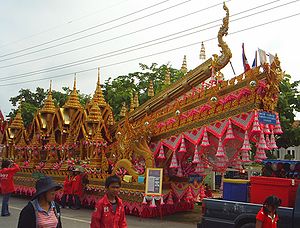Northeast Thailand, the Isan (Thai: อีสาน; also Isaan, Issan, Esarn or It on written) is the north-east, which is still largely undeveloped for tourism Thailand with rice fields, plateaus and cultural treasures.

The sub-regions of northeast Thailand

places

- Buri Ram, Home to one of the strongest football clubs in Thailand and the location of the largest international motorsport racetrack in the country
- Khon Kaen, "Unofficial capital" of the Isan
- Mukdahan, right on the border with Laos with "Indochina Market" and "Friendship Bridge"
- Nakhon Phanom
- Nakhon Ratchasima, the "gateway to Isan"
- Nong Khai, directly opposite the Lao capital, known for its fascinating sculpture park
- Roi Et
- Sakon Nakhon
- Surin, sleepy provincial town, except for the elephant festival in November
- Ubon Ratchathani
- Udon Thani
Other goals
- That phanom, Nakhon Phanom Province
- Phu Phan National Park, Sakon Nakhon Province
- Ta Phraya National Park, Buri Ram Province
- Phimai Historical Park, Nakhon Ratchasima Province
- Khao Yai National Park, Nakhon Ratchasima Province
- Thap Lan National Park, Nakhon Ratchasima Province
- Prasat Preah Vihear, Si Sa Ket Province / Cambodia border
- Kaeng Tana National Park, Ubon Ratchathani Province
- Pha Taem National Park, Ubon Ratchathani Province
language
The native language of most of the residents of northeast Thailand is Phasa Isan, an umbrella term for various dialects that occupy an intermediate position between the Thai and Lao languages (both languages are closely related, the transition is fluid). At school, however, they learn standard Thai, which is also used with authorities, spoken on the radio and written in newspapers.
English is spoken in Isan at best in tourist facilities in the larger cities, apart from that one will come across at most rudimentary knowledge. Even at the tourist office, you shouldn't necessarily expect good English. Without knowledge of Thai you have to make your way with fragmentary English or communicate “with hands and feet”.
getting there
By plane
The main airports in the northeast region are Udon Thani, Ubon Ratchathani, Khon Kaen, Nakhon Phanom, Sakon Nakhon, Roi Et and Loei. These are usually daily on domestic flights from low-cost airlines such as NokAir and Thai AirAsia served.
With the train
The northeast line of the Thai Railway runs through the Isan. This divides in Nakhon Ratchasima into a branch that leads via Buri Ram, Surin, Si Sa Ket to Ubon Ratchathani and one that passes through Khon Kaen and Udon Thani and ends in Nong Khai. From Bangkok there are 10 daily connections to Nakhon Ratchasima, 6 to Ubon Ratchathani and 3 to Nong Khai. According to the timetable, the fastest connections reach Nakhon Ratchasima in 4:15 hours, Ubon Ratchathani in 8:35 hours and Nong Khai in 10:30 hours, but there are often significant delays.
In the street
All the provinces of northeast Thailand can be reached by long-distance buses, which are in Bangkok on the north Mo Chit bus station depart.
The most important trunk road in northeastern Thailand is the Thanon Mittraphap (“Street of Friendship”), which is signposted as National Road 2. It is in parts similar to a motorway (with several lanes and separate driving directions). In Saraburi it branches off from National Road 1, leads through the provinces of Nakhon Ratchasima, Khon Kaen, Udon Thani and ends in Nong Khai at the Thai-Lao Friendship Bridge over the Mekong.
mobility
There are also numerous long-distance bus connections from one province to another within the Isan.
Tourist Attractions
- Phimai Historical Park. Khmer temple district from the Angkor period.
- Phanom Rung. Khmer temple district from the Angkor period.
activities

Nationally known and important events:
- Bun Bang Fai ("Rocket Festival"). In mid-May, in many places in Isan, but the largest in Yasothon.
- Phi Ta Khon Festival ("Spirit Festival"). With gruesome masks in Dan Sai, Loei Province in March-July (exact dates vary).
- Candle festival. To Khao Phansa (Beginning of the Buddhist monks' retreat period) on the July full moon, candles are given to the monks throughout Thailand, including in Isan, so that they can study the religious texts during the rainy season. In Ubon Ratchathani a special festival has developed from this, at which larger-than-life candles are poured, from which artistic figures are carved, which are then processed through the city.
- Ok Phansa. Buddhist holiday celebrated throughout Thailand at the end of the Buddhist retreat in October. In the Isan there are special processions with illuminated boats (lai ruea fai) held, especially in Nakhon Phanom on the Mekong and in Ubon Ratchathani on the Mun River.
- Naga fireballs. Around the full moon in October; in the eastern part of the Nong Khai Province For as yet unexplained reasons, glowing fireballs rise from the Mekong. The locals attribute the mythical water snakes.
- Elephant Buoyancy, in Surin. In November. Multi-day festival around the pachyderms with processions, shows and a simulated elephant battle.
kitchen

The Isan has its own, typical regional cuisine, which differs considerably from the cuisine of central and southern Thailand (which is better known in Europe). The staple food is here Sticky rice(Khao Niao). Many dishes are very spicy and also a bit sour. A characteristic and widely used ingredient is Pla Ra, fermented fish.
The best-known and most popular dishes of the Isan also outside of the northeast region are Som Tam, a spicy and sour salad made from unripe papaya, as well Kai Yang, a kind of grilled chicken. The northeast Thai cuisine is much more diverse. Other typical dishes are Lap (or Larb), a very spicy salad made from minced meat (raw or cooked) as well Nam Tok, also a salad, but based on grilled meat. Another classic of Isan's cuisine is Tom Saep (also Tom Sap, Sab or Zab written), a spicy soup with meat and offal (typically beef).




